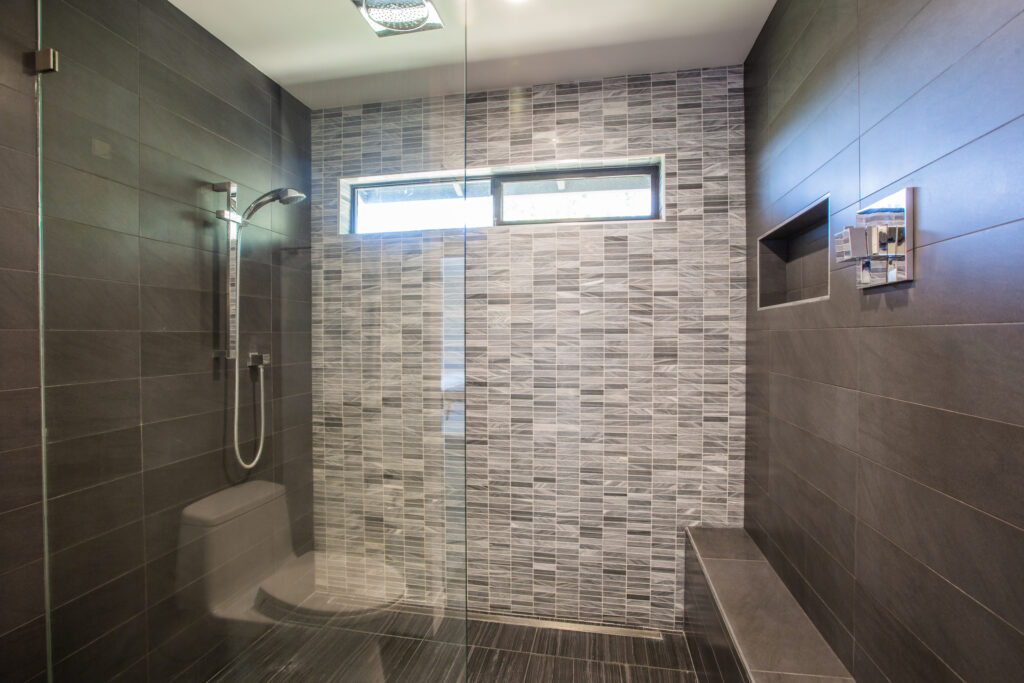Shower Replacement: A Complete Guide

If your shower is no longer meeting your needs—whether it’s due to persistent leaks, weak water pressure, or a design that feels stuck in the past—it might be time for a change. A shower replacement doesn’t just solve these issues; it can completely upgrade the look and functionality of your bathroom, making it a space you enjoy every day.
In this guide, we’ll help you identify when it’s time for a replacement, explore the options available, and break down the installation process step by step.
Table of Contents
Signs You Need a Shower Replacement
Knowing when it’s time for a shower replacement can save you time, money, and stress. Recognizing these signs early ensures your bathroom remains safe, functional, and visually appealing.
Visible Damage or Wear
Physical damage like cracks in the shower pan, chipped tiles, or leaking joints are often the first indicators that replacement is needed. Over time, water from leaks can seep into walls and floors, leading to mold, mildew, and structural damage.
Key Indicators:
- Persistent water pooling or leaks.
- Mold or mildew growth that returns despite cleaning.
- Discoloration or stains on tiles and grout.
Outdated Design
An outdated shower can make your bathroom feel dull and uninspiring. If your current shower doesn’t align with modern trends or your personal style, a replacement can provide a fresh start and increase your home’s resale value.
Benefits of Modern Designs:
- Frameless glass enclosures for a sleek look.
- Enhanced functionality with dual showerheads or rain-style fixtures.
- Improved lighting and accessibility features.
Reduced Functionality
Does your shower take too long to drain, or is the water pressure inconsistent? Reduced functionality often indicates worn-out plumbing, outdated fixtures, or poor design that can be resolved with a replacement.
Common Issues:
- Slow drainage caused by hidden pipe damage.
- Fluctuating water temperatures or pressure.
Energy Efficiency Concerns
Older showers can waste significant amounts of water and energy, leading to higher utility bills. Replacing your outdated shower with modern, eco-friendly alternatives improves efficiency while conserving natural resources. Today’s shower systems are designed to reduce waste without compromising performance, comfort, or convenience.
Low-Flow Showerheads
Low-flow showerheads are a popular upgrade that drastically reduces water usage while maintaining strong water pressure. Traditional showerheads use around 2.5 gallons of water per minute (GPM), but modern low-flow models cut this down to 1.5–2.0 GPM. This means you save thousands of gallons of water annually, directly lowering your water bills.
Thermostatic Valves
Thermostatic valves offer precise temperature control, allowing you to set and maintain your preferred water temperature consistently. These valves adjust automatically to changes in water pressure, preventing sudden temperature fluctuations that lead to wasted water while you fiddle with settings. This not only minimizes water waste but also ensures a more comfortable and predictable shower experience. By reducing the time spent adjusting the temperature, thermostatic valves combine efficiency with convenience, making them an ideal eco-friendly upgrade.
Smart Shower Systems
Modern smart shower systems take water conservation to the next level with features like timers, temperature displays, and water usage trackers. These systems help you monitor how much water you’re using and encourage mindful habits, like shorter showers. Some even allow you to pre-set water flow and temperature, ensuring you use only what’s needed. This real-time control makes it easier to save water and energy while simplifying your routine with automated settings.
Water-Saving Materials and Features
Beyond fixtures, modern showers can incorporate other eco-friendly components. Aerators, for example, mix air with water to create a satisfying spray while using less water. Materials like recycled tiles, water-repellent surfaces, and sustainable flooring not only reduce environmental impact but also add durability and style to your bathroom. Together, these features create a space that feels both functional and environmentally responsible.
Types of Shower Replacements
Selecting the right shower type is one of the most important decisions in the replacement process. Each option offers unique benefits and considerations.
Pre-Fabricated Shower Kits
Pre-fabricated kits are an excellent choice for homeowners seeking affordability and simplicity. They typically include walls, a shower base, and sometimes doors, making installation straightforward.
Advantages:
- Cost-effective compared to custom options.
- Available in various sizes and finishes.
- Ideal for DIY projects due to ease of assembly.
Limitations:
- Fewer customization options.
- May not fit irregular or unconventional spaces.
Custom Showers
Custom showers offer complete design flexibility, allowing you to create a one-of-a-kind space tailored to your needs.
Advantages:
- Fully customizable layouts, materials, and features.
- Suitable for unique bathroom dimensions.
- High-end finishes like marble or porcelain tiles.
Limitations:
- Significantly higher cost.
- Longer installation times.
Walk-In Showers
Walk-in showers are doorless and often frameless, providing an open and modern look. They’re especially popular for their accessibility and ease of maintenance.
Advantages:
- Easy entry, ideal for seniors or those with mobility issues.
- Creates a spacious and airy feel.
- Minimalist, modern design.
Considerations:
- Requires proper waterproofing to prevent water spills.
- Not always suitable for small bathrooms.
Tub-to-Shower Conversions
Converting an unused bathtub into a shower can optimize bathroom space and improve daily convenience.
Advantages:
- Makes better use of space, particularly in small bathrooms.
- Allows for modern updates like sliding glass doors or walk-in features.
Considerations:
- May require plumbing adjustments.
- Loss of a bathtub could affect resale value.
Shower Replacement Process
Replacing a shower involves several steps, from preparation to finishing touches. Understanding each stage ensures a smooth project with fewer surprises.
Initial Assessment
Start by evaluating your current shower. Determine if plumbing needs to be updated or if structural repairs are necessary. Consulting a professional can provide insights into potential challenges.
Key Steps:
- Measure your shower area to choose a replacement that fits.
- Inspect pipes for leaks or corrosion.
- Identify structural damage, such as water-damaged walls or floors.
Demolition and Removal
Removing the old shower is a crucial step that requires care to avoid damaging surrounding areas.
What to Expect:
- Disconnect water supply lines.
- Remove old tiles, shower doors, and fixtures.
- Safely dispose of debris.
Plumbing and Waterproofing
Proper plumbing and waterproofing are vital to ensure your new shower functions correctly and prevents leaks.
Key Tasks:
- Replace outdated pipes with durable materials like PEX or copper.
- Install waterproof membranes or backer boards on walls and floors.
Installing the New Shower
Whether you’re using a pre-fabricated kit or a custom design, following a systematic approach is essential for proper installation.
Installation Steps:
- Assemble or fit the shower base.
- Install wall panels or tiles, ensuring precise alignment.
- Attach fixtures like showerheads and valves.
Finishing Touches
The final step involves sealing joints, grouting tiles, and adding accessories like shelves or grab bars. These details complete the look and functionality of your shower.
How long does a shower replacement take?
The time it takes to replace a shower varies based on the scope of the project, the type of shower being installed, and whether you’re doing it yourself or hiring a professional.
- Pre-Fabricated Shower Kits: These are the quickest to install, typically taking 1 to 3 days. This includes removing the old shower, preparing the area, and installing the new unit.
- Custom Showers: Custom designs often require more time, taking anywhere from 5 to 14 days. This timeframe accounts for demolition, plumbing adjustments, tiling, and finishing work.
- Tub-to-Shower Conversions: These projects fall somewhere in the middle and usually take 3 to 7 days, depending on plumbing needs and customization.
Additional time might be required for inspections if permits are involved or if unexpected repairs, like fixing water damage or upgrading plumbing, are needed.
Cost of Shower Replacement
Shower replacement costs can vary widely depending on factors like materials, labor, and the complexity of the project.
Factors That Influence Costs
- Materials: High-end materials like marble or custom glass are more expensive than acrylic or fiberglass.
- Labor: Professional installation costs depend on local rates and project complexity.
- Plumbing Updates: Repairs or upgrades can significantly increase costs.
Average Price Ranges
- Pre-Fabricated Kits: $1,000–$4,000, including installation.
- Custom Showers: $6,000–$10,000+ for premium finishes and designs.
- Tub-to-Shower Conversions: $2,000–$7,000, depending on plumbing needs.
How to Budget for a Shower Replacement
- Allocate 20% of your budget for unexpected repairs.
- Compare estimates from multiple contractors to find the best deal.
- Look for financing options or seasonal discounts.
DIY vs. Hiring a Professional
Whether to tackle the project yourself or hire a professional depends on your skill level, the complexity of the job, and your budget.
When DIY Makes Sense
- Installing pre-fabricated kits with straightforward instructions.
- Completing minor updates like replacing fixtures or re-grouting tiles.
Benefits of Hiring a Pro
- Professionals bring experience and tools, ensuring high-quality work.
- Many contractors offer warranties on their services.
- They can handle complex tasks like plumbing adjustments and custom designs.
Risks of DIY Shower Replacements
- Improper installation can lead to leaks or water damage.
- Lack of experience can result in wasted materials or costly mistakes.
Common Mistakes to Avoid During a Shower Replacement
Avoiding mistakes during a shower replacement can save you time, money, and frustration. Here are some common pitfalls and tips to steer clear of them:
Skipping Waterproofing
Proper waterproofing is essential to prevent leaks and mold growth. Make sure all walls and floors are thoroughly waterproofed before installing tiles or panels to protect your bathroom from future water damage.
Poor Measurements
Accurate measurements are critical for a seamless fit. Double-check the dimensions of your shower space, including height, width, and depth, before purchasing materials. Mistakes here can lead to improper fits and costly delays.
Using Low-Quality Materials
While cheaper materials might seem like a bargain, they tend to wear out faster, leading to repairs or replacements sooner. Investing in high-quality, durable materials will save you money in the long run.
Improper Drainage Installation
Ensure the shower floor is correctly sloped toward the drain to avoid water pooling. Improper drainage can cause standing water, which may damage your shower and surrounding areas over time.
DIYing Beyond Your Skill Level
While some tasks are manageable for DIYers, complex jobs like plumbing adjustments or custom tiling are best left to professionals. Attempting work beyond your expertise can result in costly errors and repairs.
By avoiding these common mistakes, you can ensure your shower replacement is smooth, efficient, and built to last.
Tips for Choosing the Right Shower
Finding the right shower is all about balancing functionality, style, and durability. With several options for materials, layouts, and features, it’s important to consider what works best for your space and lifestyle.
Material Options
The ideal materials for your shower depend on your budget, maintenance preferences, and design goals. Here’s a comparison of popular options for walls, bases, and fixtures:
Shower Walls
- Tile: Porcelain and ceramic tiles are durable, water-resistant, and offer endless design options. However, they require regular grout maintenance to prevent mold and staining.
- Fiberglass and Acrylic: Lightweight, affordable, and easy to clean, these materials are perfect for pre-fabricated showers and low-maintenance solutions.
- Natural Stone: Options like marble or travertine provide a luxurious, high-end look but require regular sealing and upkeep to prevent stains and water damage.
Shower Base
- Acrylic or Fiberglass Pans: These are cost-effective, lightweight, and low-maintenance, making them a common choice for pre-fabricated shower kits.
- Tile Bases: Custom tiled shower bases offer a seamless, elegant appearance but come at a higher cost and require professional installation.
- Solid Surface Materials: Premium materials like cultured marble are durable, stylish, and provide a sleek, modern finish.
Fixtures
- Stainless Steel and Chrome: Affordable, durable, and resistant to rust, these are practical options for most bathrooms.
- Brushed Nickel or Oil-Rubbed Bronze: These finishes add a stylish, modern, or rustic touch, depending on your bathroom’s design theme.
By carefully selecting the right materials for each component, you can create a shower that combines durability, easy maintenance, and a look that aligns with your personal style.
Size and Layout Considerations
The size of your bathroom will influence the shower layout you choose. Carefully measure your space to ensure a proper fit and avoid overcrowding.
- In smaller bathrooms, space-saving designs like corner showers are a practical option. They provide functionality without compromising comfort.
- For larger spaces, you can explore more elaborate layouts, such as walk-in showers, which combine convenience with a sleek design.
Energy-Efficient Features
Incorporating energy-efficient features can make your shower more sustainable and cost-effective:
- Low-flow showerheads and aerators: These reduce water consumption while maintaining satisfying water pressure, helping you save on utility bills.
- Eco-friendly materials: Consider using sustainable or recycled materials for your shower surfaces to reduce your environmental impact.
By carefully considering the material, size, layout, and energy-efficient upgrades, you can create a shower that fits your style, maximizes space, and helps conserve resources—all while ensuring long-term durability and performance.
Frequently Asked Questions
Can I replace just the shower pan?
Yes, replacing just the shower pan is possible if the surrounding walls, tiles, and plumbing are in good condition. However, ensuring the new pan is compatible with your existing enclosure can be challenging, especially in older showers where a custom pan may be needed.
The process involves removing the old pan, inspecting the subfloor, and ensuring proper waterproofing before installation. Because precision is crucial to avoid leaks, hiring a professional is often the best choice.
What permits are required for a shower replacement?
Permit requirements for shower replacement projects depend on your location and the scope of the work. Generally, permits are needed for significant changes, such as plumbing alterations, structural modifications, or electrical work. For example, moving a shower to a new location or adding features like lighting or ventilation systems often requires plumbing or electrical permits. Expanding or altering the shower area may also necessitate a building permit.
To obtain a permit, contact your local building department to confirm requirements. While some jurisdictions allow homeowners to apply directly, others may require a licensed contractor to handle the process. Permits are essential to ensure the work complies with local building codes, helping to prevent issues like leaks, water damage, or structural instability. Proper permits are also important when selling your home, as unpermitted work can lead to fines or complications during inspections.
Permit costs typically range from $50 to $300, depending on the project and location. It’s important to factor in the approval timeline, as the process can take anywhere from a few days to several weeks, depending on your jurisdiction.
Do I need to replace the entire shower, or can I update parts of it?
You don’t always need to replace the entire shower; sometimes, upgrading individual components can be enough. For example, replacing shower doors can modernize the space if they’re outdated or damaged, while upgrading fixtures like showerheads, faucets, or handles can enhance both functionality and style. Additionally, tasks like re-grouting tiles and resealing joints can refresh the shower’s appearance and prevent leaks, offering a simple and cost-effective solution.
However, a full replacement may be necessary if the shower pan, tiles, or plumbing are significantly damaged. Persistent issues like leaks, mold growth, or structural problems that extend beyond surface components also warrant replacing the entire unit.
From a budget perspective, partial updates are more affordable, typically ranging from a few hundred to a few thousand dollars depending on the components replaced. Full replacements, while more expensive, address underlying issues comprehensively and provide a more cohesive, long-lasting design.
Conclusion
A shower replacement can transform your bathroom, enhancing its functionality, style, and value. By understanding the signs, exploring your options, and planning each step, you can achieve a successful outcome. Whether you choose to DIY or hire a professional, this guide provides the knowledge you need to start your shower replacement project with confidence.
Ready to upgrade your shower? Consult a trusted contractor today!
Sources
Additional Bathroom Remodel Resources
- Choosing the Right Tile for Your Shower
- 2025 Bathroom Remodel Cost Guide
- Guide to Home Modifications: Aging in Place

Anna has over six years of experience in the home services and journalism industries and serves as the Content Manager at MyHomePros.com, specializing in making complex home improvement topics like HVAC, roofing, and plumbing accessible to all. With a bachelor’s degree in journalism from Auburn University, she excels in crafting localized, comprehensive guides that cater to homeowners’ unique needs. Living on both coasts of the United States has equipped her with a distinctive perspective, fueling her passion for turning any house into a cherished home through informed, personalized decision-making.








